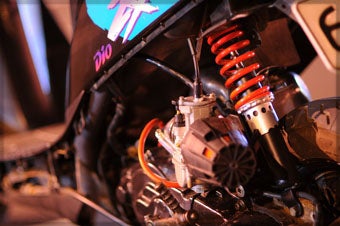|
||
| Scooter Tuning Overview |
Scooter tuningSo you want more power from your scooter. Welcome to the club. Scooter tuning is very popular throughout the world. A vast array of aftermarket performance parts are available for many applications, from circuit or drag racing to high performance street duties. Should you start upgrading parts on your scooter? If the scooter is still under warranty, and you want more power then be very careful as performance modifications usually void the warranty. You have been warned! Also many countries have laws in regards to the top speed or maximum KW output of mopeds (Generally 50cc scooters). Make sure you check this or you could find you’re breaking the law in your country. If you can’t control your need for power or don’t have a warranty on your scoot – then read on. Before starting, have a read of our maintenance article and make sure that your scooter is in good working order. No point tuning a scooter that won’t be up for the challenge: If you deem your machine ready then the work can begin!
Derestriction(Mostly applies to 50cc scooters)
Many modern 50cc scooters are restricted. This is usually done to limit the top speed.
Once you’ve worked out what is restricting the scooter and replaced/or removed that restriction. You should find the bikes full potentional. Be wary of spending hours de-restricting your scooter if you’re planning on further upgrades that will result in restricted parts being binned. It may pay to combine the de-restricting with power upgrades. i.e. instead of spending ages drilling out a restriction in the standard exhaust pipe, replace the entire system with an after market model; the end result will equal more power. ExhaustThis should be one of your first choices when tuning a scooter. This is especially true for a 2-stroke motor. The shape and internal diameter of the exhaust has a large impact on the power of a two-stroke motor. In a four stroke the increase won’t be as pronounced, but still is key part of the tuning process. IntakeThere are three parts to the intake of most scooters:
ChamberThe cubic capacity of an engine is the largest contributing factor to ultimate horsepower in naturally aspirated engines. The reason for this is the amount of power generated is greatly affected by the volume of combustible material i.e. fuel and air the engine can burn each cycle. Getting 10hp from a 125cc engine is a lot easier than from a 50cc, therefore, increasing capacity is an easy way to vastly improve the power of your scooter. Removing the existing piston and head and replacing it with a larger capacity combination is an easy and effective power-up. Other UpgradesThere are a variety of other methods of acheiving greater horsepower from your engine. Some of these include; turbocharging, nitrous gas and supercharging... this discounts of course the validity of tying a few clydesdales to the scooter... We will delve further into these more extreme options in another installment... DrivelineThe majority of modern scooters use a Continuous Variable Transmission (CVT) system, this is often referred to as an 'automatic' or 'twist and go" transmission. There is a front and rear variator joined by a belt. As the bike accelerates the front variator pushes the belt to the outside or top, creating a bigger “gear†. At the same time, the rear variator lets the belt move to the centre, allowing a smaller “gearâ€.
When tuning begins the maxium power output of the engine moves to different points in the Rpm range, therefore it is important to alter when the variators allow the belt to move. If too early then the engine bogs down, like changing into fifth gear in a car while only travelling at 20kph. Another possible scenario is that the engine revs too high, this will again slow the scooter down and increase wear and tear on the engine by running it at the red line for increased periods. One of the ways the driveline can be altered is by changing the weight of the rollers in the front variator, this will change how and when force is applied to the belt. A lighter set of rollers will move the belt out lower in the rev range. The converse will happen with heavier rollers. There are many after-market ‘high-speed’ variators, These work in two ways firstly they increase the surface area for the belt, in other words increasing the size of the top gear, allowing more top end speed. In addition to this the ramp that the rollers use is on a steeper angle, giving sharper acceleration. In the next installment we will venture into the basics of handling including suspension, tyres and brakes. |
| Last Updated ( Saturday, 07 June 2008 14:34 ) |











